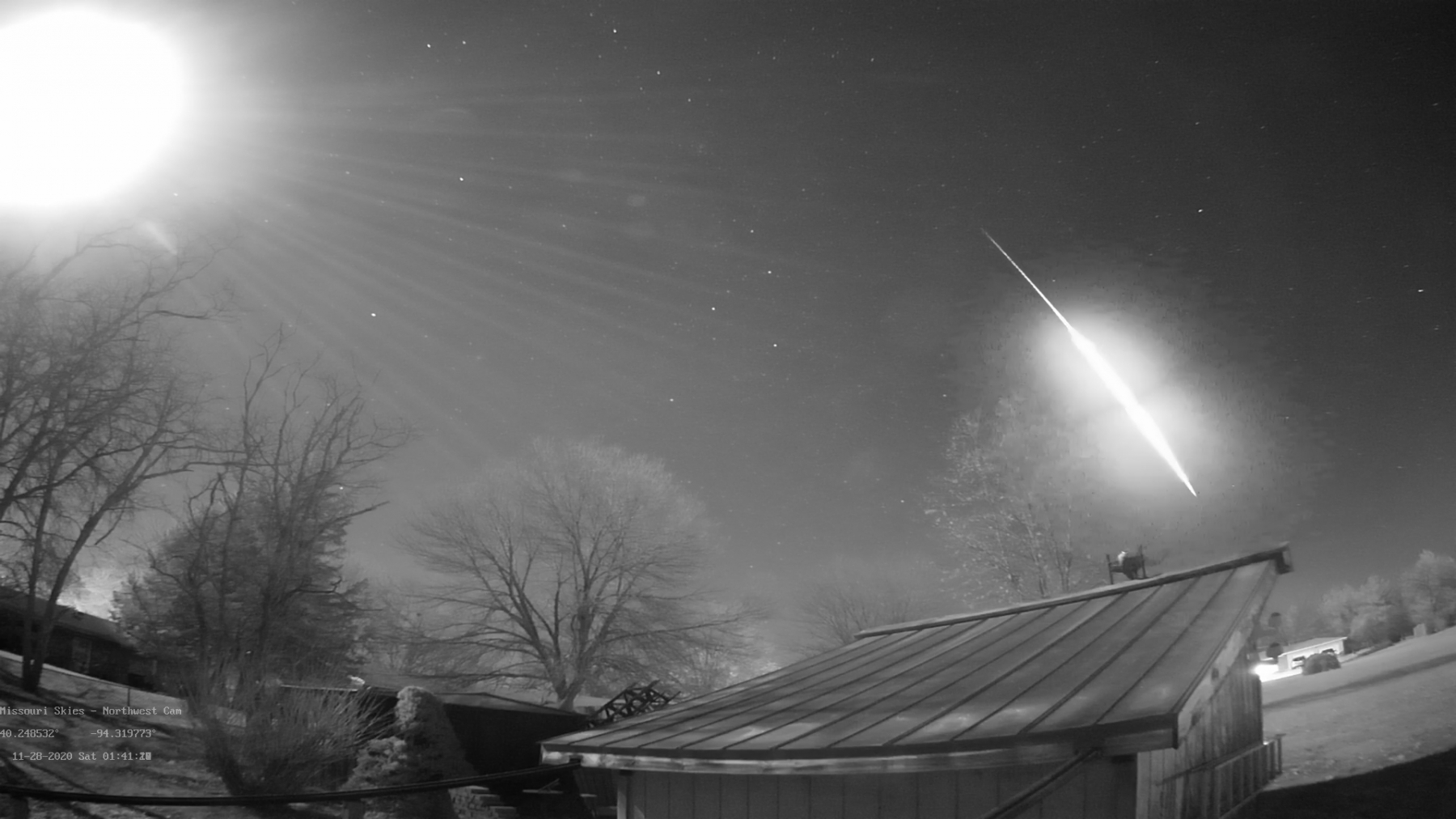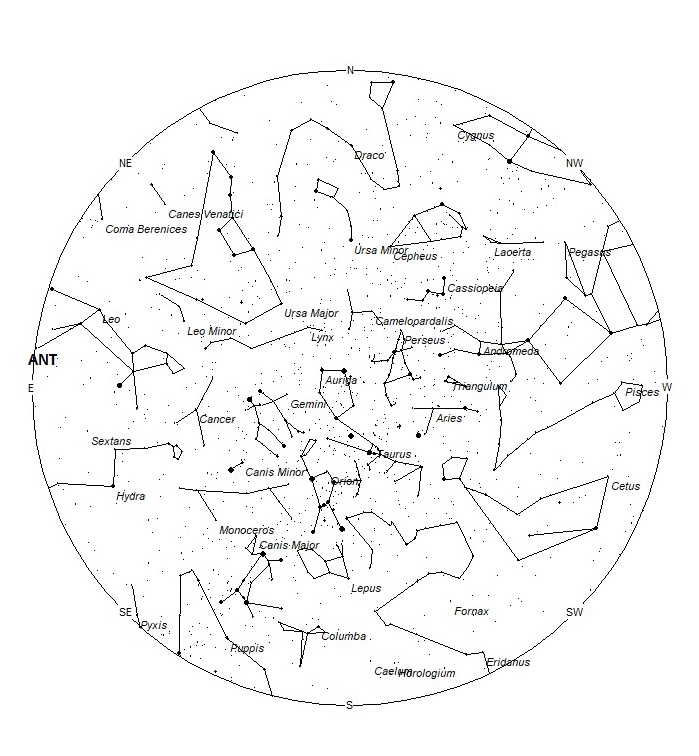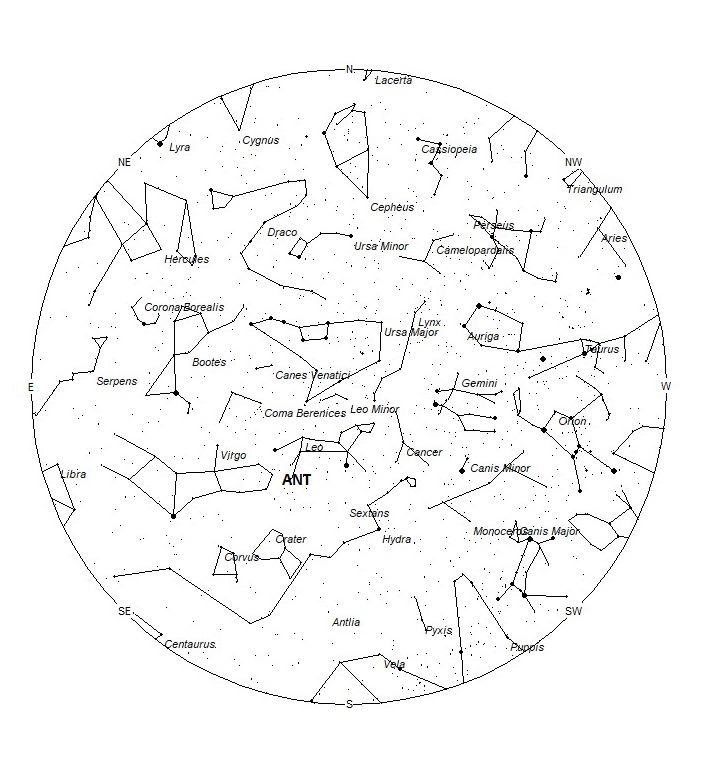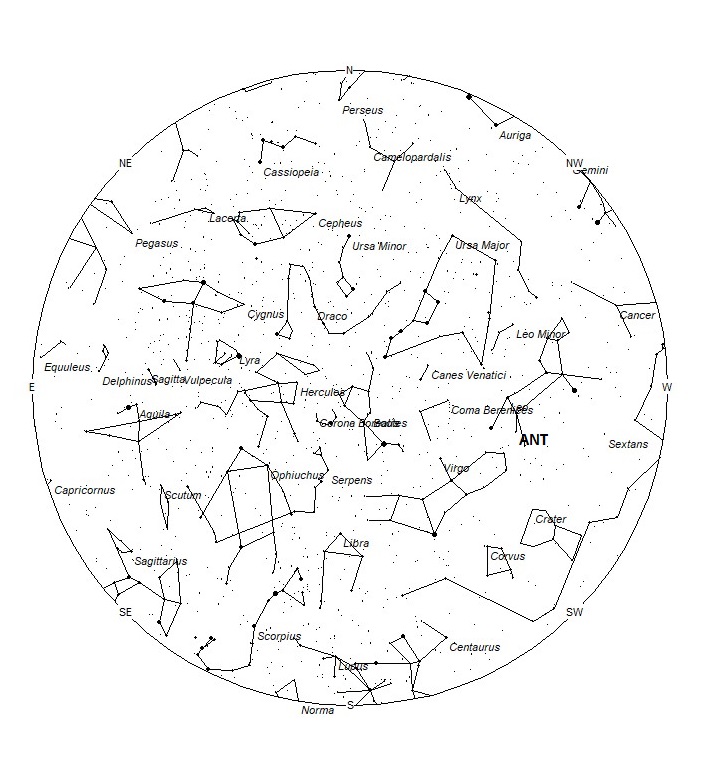 Daniel Bush captured this brilliant fireball from Albany, Missouri, USA, on 28 November 2020, at 07:41 UT (1:41am CST). Credit Daniel Bush
Daniel Bush captured this brilliant fireball from Albany, Missouri, USA, on 28 November 2020, at 07:41 UT (1:41am CST). Credit Daniel BushDuring this period the moon waxes from half-illuminated to full. This weekend the waxing gibbous moon will set during the early morning hours, leaving the remainder of the night free of interfering moonlight. With each passing night this window of dark sky decreases until late in the period the moon will set at the start of morning twilight. The estimated total hourly meteor rates for evening observers this week is near 3 as seen from mid-northern latitudes and 4 as seen from tropical southern locations (25S). For morning observers, the estimated total hourly rates should be near 8 as seen from mid-northern latitudes (45N) and 14 as seen from tropical southern locations (25S). The actual rates will also depend on factors such as personal light and motion perception, local weather conditions, alertness, and experience in watching meteor activity. Evening rates are reduced due to moonlight. Note that the hourly rates listed below are estimates as viewed from dark sky sites away from urban light sources. Observers viewing from urban areas will see less activity as only the brighter meteors will be visible from such locations.
The radiant (the area of the sky where meteors appear to shoot from) positions and rates listed below are exact for Saturday night/Sunday morning February 20/21. These positions do not change greatly day to day so the listed coordinates may be used during this entire period. Most star atlases (available at science stores and planetariums) will provide maps with grid lines of the celestial coordinates so that you may find out exactly where these positions are located in the sky. A planisphere or computer planetarium program is also useful in showing the sky at any time of night on any date of the year. Activity from each radiant is best seen when it is positioned highest in the sky, either due north or south along the meridian, depending on your latitude. It must be remembered that meteor activity is rarely seen at the radiant position. Rather they shoot outwards from the radiant, so it is best to center your field of view so that the radiant lies at the edge and not the center. Viewing there will allow you to easily trace the path of each meteor back to the radiant (if it is a shower member) or in another direction if it is sporadic. Meteor activity is not seen from radiants that are located far below the horizon. The positions below are listed in a west to east manner in order of right ascension (celestial longitude). The positions listed first are located further west therefore are accessible earlier in the night while those listed further down the list rise later in the night.
These sources of meteoric activity are expected to be active this week.
.
The Anthelion (ANT) radiant is active from a position located at 11:00 (165) +06. This position lies in southeastern Leo, 4 degrees west of the 4th magnitude star known as sigma Leonis. Since this radiant is a very large oval, some thirty degrees wide by fifteen degrees high, activity from this radiant can appear from more than one constellation., This week these meteors can also be seen from the constellation of Sextans and western Virgo, as well as southeastern Leo. The position listed here is for the center of the radiant. This radiant is best placed near 01:00 LST when it lies on the meridian and is highest in the sky. Rates at this time should be near 2 per hour no matter your location. With an entry velocity of 30 km/sec., the average Anthelion meteor would be of slow velocity.
As seen from the mid-northern hemisphere (45N) one would expect to see approximately 6 sporadic meteors per hour during the last hour before dawn as seen from rural observing sites. Evening rates would be near 2 per hour. As seen from the tropical southern latitudes (25S), morning rates would be near 12 per hour as seen from rural observing sites and 3 per hour during the evening hours. Locations between these two extremes would see activity between the listed figures. Evening rates are reduced due to moonlight.
The list below offers the information from above in tabular form. Rates and positions are exact for Saturday night/Sunday morning except where noted in the shower descriptions.
| SHOWER | DATE OF MAXIMUM ACTIVITY | CELESTIAL POSITION | ENTRY VELOCITY | CULMINATION | HOURLY RATE | CLASS |
| RA (RA in Deg.) DEC | Km/Sec | Local Standard Time | North-South | |||
| Anthelion (ANT) | – | 11:00 (165) +06 | 30 | 01:00 | 2 – 2 | II |
 American Meteor Society
American Meteor Society



White singular ball of white light speeding north from San Diego at 11:00 Feb 19, 2021
Friday.
YES!! Thank you for seeing it too… & confirming it. It was an amazing surprise.
In Seaford, Delaware at approximately 3:35am, hubby and I saw the biggest and brightest meteor either of us ever saw. It came from the southeast and went towards the northeast. It started out with a greenish tail which turned yellow as it went. It was truly amazing!
I saw a bright shooting fireball at around 6:25 am on Thursday 2/25/21 in Southfield Michigan driving into work. I saw something out of the corner of my left eye then turned toward my left and saw what looked like a shooting star but much much bigger and brighter and closer in the sky. I was in awe. So amazing to see. I couldn’t believe how bright and big and close it was.
I’m in Canton and saw this during my morning walk! I texted my husband that it almost looked like a firework or plane crash! It was 6:27 when I texted him. I’m happy to hear that someone else saw it.
I was driving home tonight in fredonia, NY and was amazed when I saw the brightest meteor I’ve ever seen in my life. It was SO close
I just saw one bright shooting star tonight at 10:04 pm Feb 26, 2021 at North West of Hwy 410 by Winston Churchill in Mississauga, Ontario Canada.
On 2/24/21, between 1930-2030 in DFW, I observed a large yellow light move fast across the sky. Originally, I thought it was a plane as we have a small airport nearby. However, the light was traveling faster than any plane should be traveling at that altitude. As I began to question whether I was looking at a jet, (I reminded myself I wasn’t near a military base so the probability that the light was a jet was very low) the light got brighter and then disappeared. I’ve seen “shooting stars” before and they lasted seconds. This light was visible for way longer.
We saw it also between the same time! It’s been on my mind all week and I found this site. We were heading east to Forney area when we saw it. I was trying to figure out what it was that it didn’t occur to me to record it, but now I wish I had.
Feb.26.2021
Woodstock, ON
Never seen this big of a light shooting across the sky before.Green in colour, bigger than any “shooting star ” I have ever seen